11 Curriculum Integration
“Curriculum integration facilitates the pursuit of new knowledge and meaning by transcending the disciplines of knowledge rather than abandoning them.” —James A. Bean
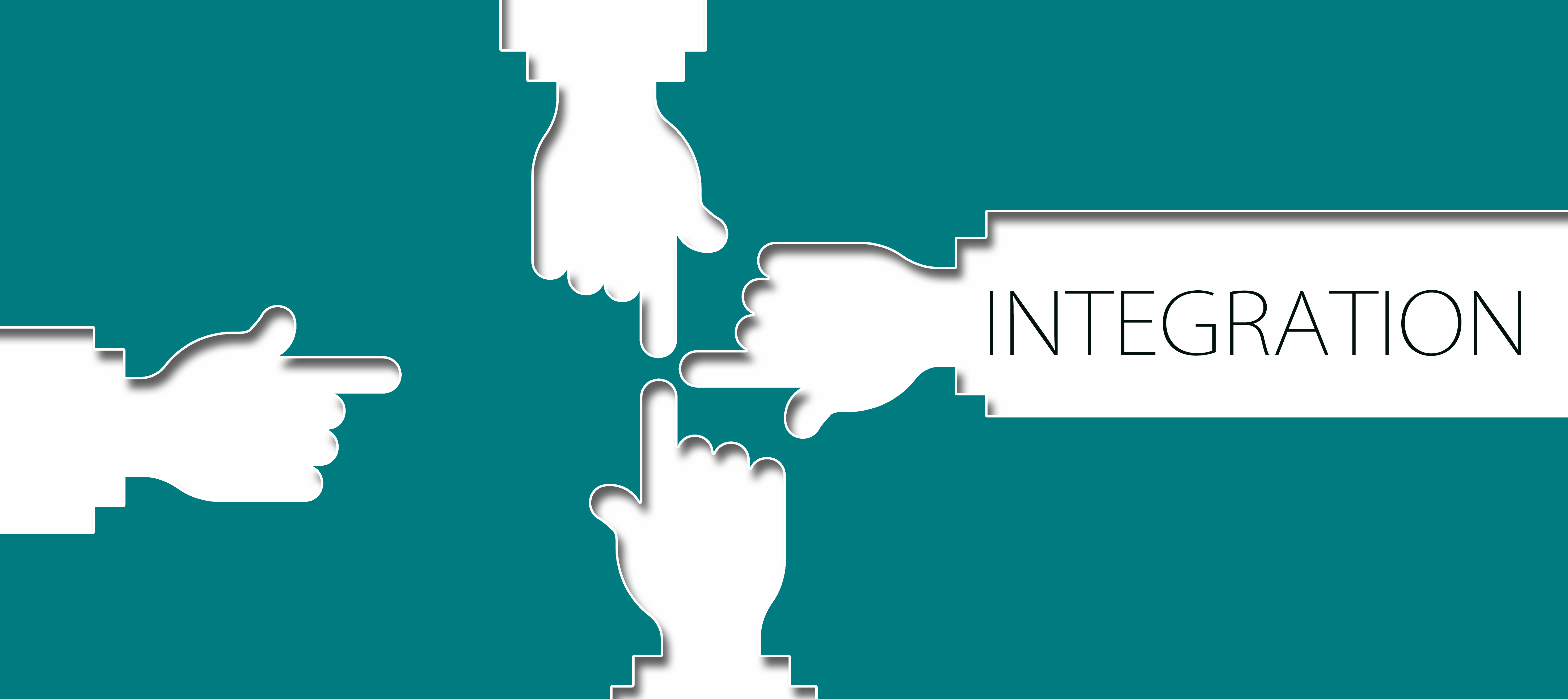
Introduction
Traditional education structures curriculum into separate disciplines, or the school-based subjects of science, mathematics, language arts, etc. In moving beyond the view of curriculum as a collection of these disciplines, some experts have challenged educators to look at curriculum from a different perspective. The integration of subject area disciplines goes back to ancient Greece when students learned geometry, rhetoric, philosophy, poetry, music and more. To the Greeks, the goal of knowledge was to acquire an education that would serve the well-being of the family, community, and the city (Jaegar, 1986).
More recently, curriculum integration is often based on the premise that curriculum should be based on issues, concerns, and problems from real life and then organizing units or themes that extend beyond separate subject areas.
A research study that focuses on curriculum integration is included in this chapter to serve as a bridge between what happens in the classroom and how research findings can inform teaching practice.
Essential Questions
- What are some major benefits of integrating curriculum?
- What are the criticisms of integrated curricula?
- How can curriculum integration be used to motivate students and incorporate standards more efficiently?
- How do the results of the ULINCS research project show that curriculum integration and professional development support student achievement?
Wilson’s Integrating Curriculum in Degrees
from Leslie Owen Wilson’s The Second Principle.
The rationale for the separate-subject approach has most often been based on the philosophy that the purpose of education is to master facts, principles, and skills in a specific content area. Proponents of integrated curriculum hold to the belief that the mastering of facts is secondary to making curriculum meaningful through the integration of subject areas and problem-solving.
Wilson (2020) explains that curriculum integration takes time and a willingness to learn something about other’s disciplines. It enables educators to fully understand new perspectives and latch onto the available possibilities for interesting fusions. Wilson goes on to describe the steps in creating integrated curriculum outlined as follows:
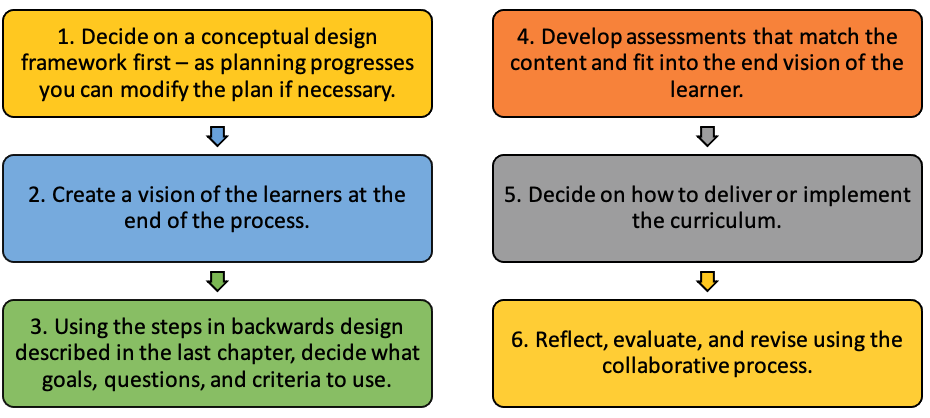
She goes on to list some powerful reasons to consider integrating the curriculum, especially in our current era of TMI or “too much information” as well as some of the criticisms of integrating curriculum as the proceeding shows.
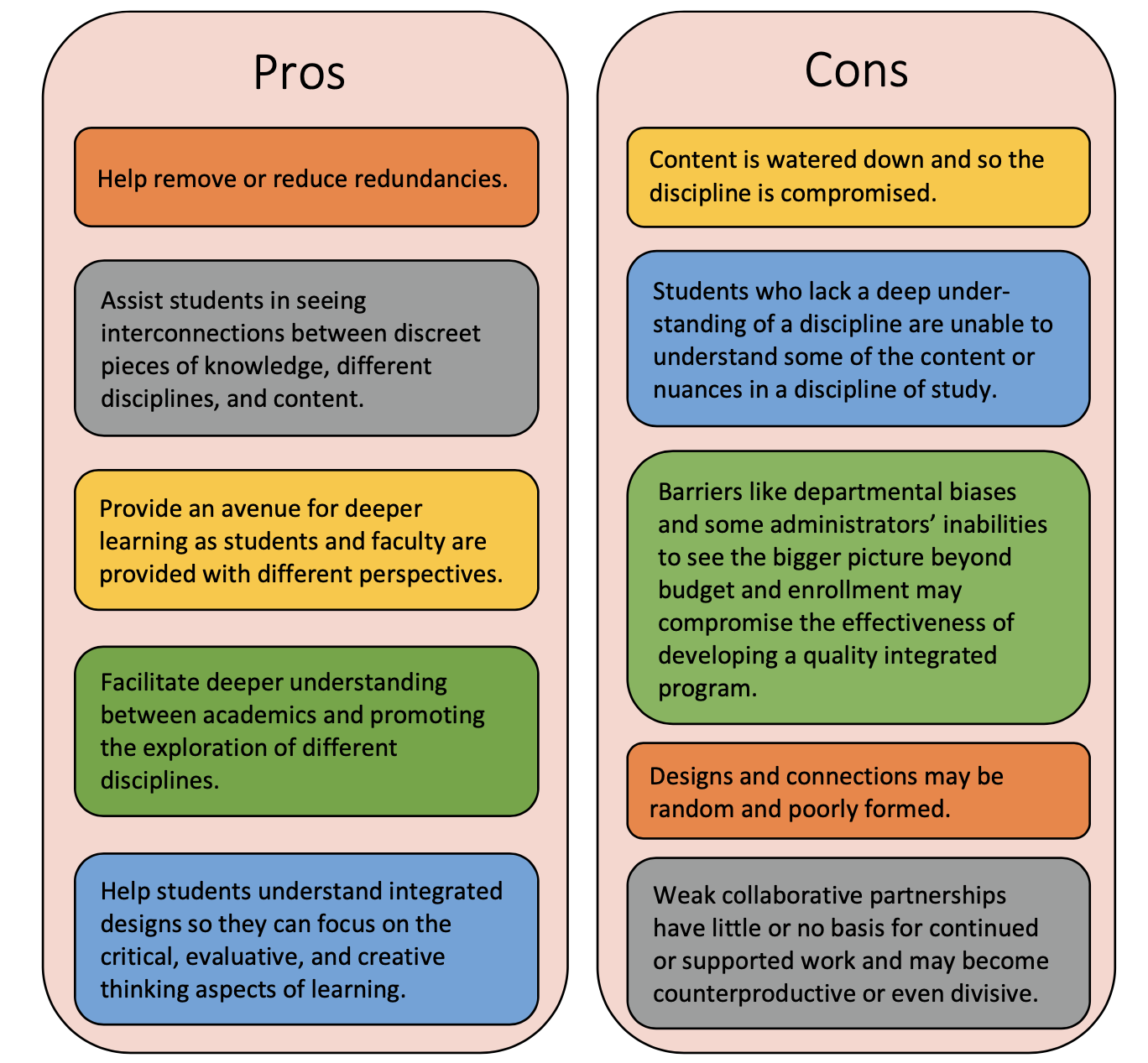
She goes on to say that there are specific actions that can facilitate curriculum integration expressed as follows:
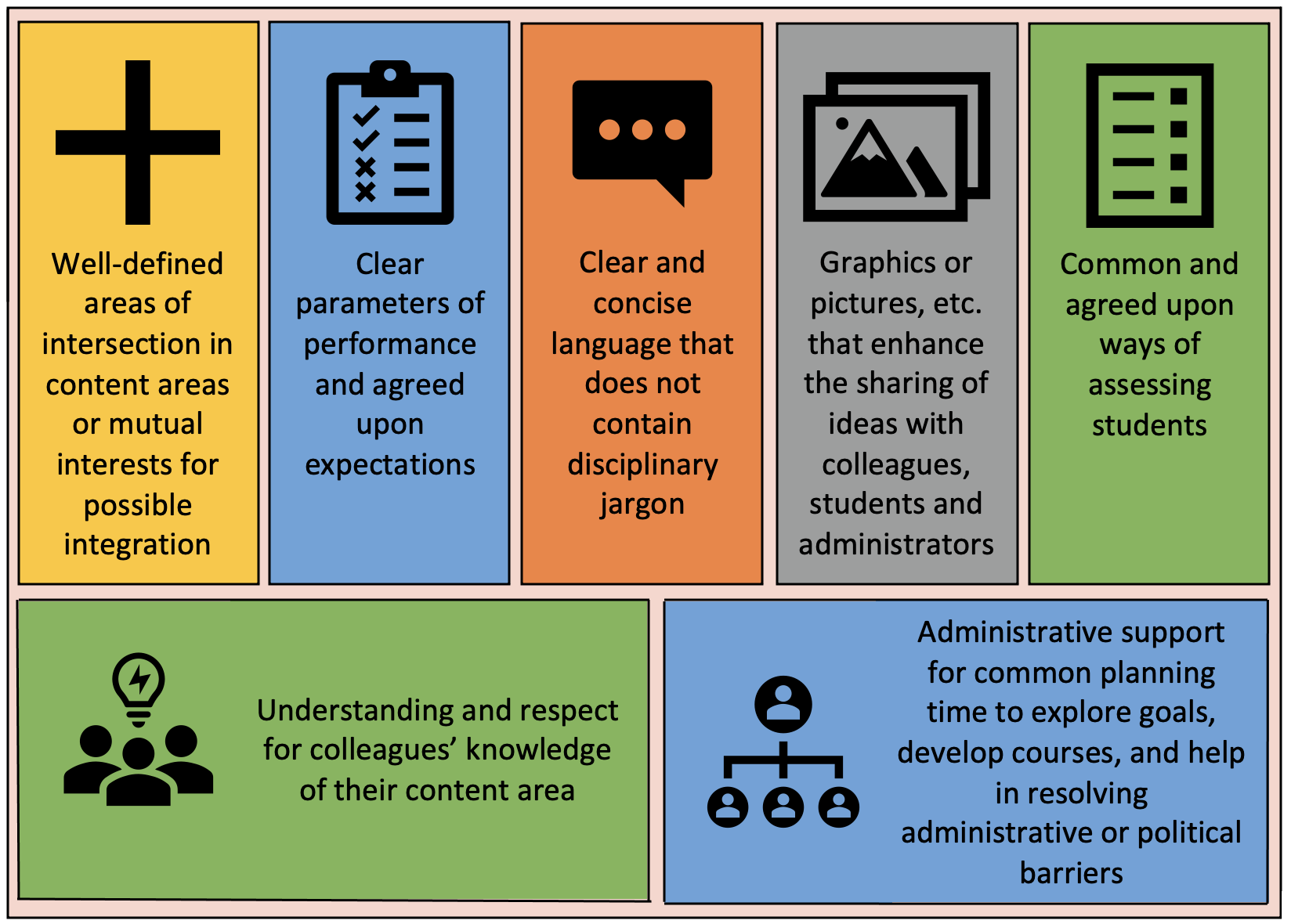
For more on Wilson’s view of integrating curriculum, access The Second Principle: Integrating Curriculum by Degrees. One example of an integrated curriculum combined with staff development is described in the following research study. The project demonstrates how discrete content standards for science, literacy, and mathematics can be combined into a synthesized standard that serves as the basis for curriculum units integrating literacy and math within the context of elementary school science. Some teaching and learning strategies are also described.
ULINCS: An Integrated Learning Experience with University Faculty, Teachers and Students
From Using literacy integration to communicate scientifically (ULINCS), Forum on Public Policy.
When academic standards for reading, writing, and mathematics were introduced in the state of Colorado, the teachers in one metropolitan district were concerned that science would become less of a priority in teaching because it was not assessed. The question became “Can science be a link for learning literacy and mathematics?” In the past, it was easier to teach all the subjects in a day, week, or school year. With the advent of state standards and assessments, things changed. Across the state of Colorado and the country, teachers confronted the challenge of teaching all the “basics” of reading and math, with little or no time left to teach the content areas that form the important building blocks in children’s lives and learning. The question then became, “Is it possible to include rich content and still keep an eye on the state assessment scores for students?” The answer was a resounding, “Yes!” There was a way to teach content areas, like science, and have high scores, and perhaps even have fun in the process.
A broader more comprehensive view of teaching and the notion of integrating learning from different disciplines harkened back to the ancient teachings of Pythagoras, who viewed content areas as unified. In practice, this translated into the one-teacher classroom where a “theme unit” was often presented. Teachers diligently collected every curricular material possible on favored subjects such as butterflies or apples. They felt that by using a designated theme across different subject areas such as math, reading, and science, they were integrating the subject matter. This pedagogy held sway for some time, but the trend in education returned to separating the disciplines to address national, state, and district-wide standards. Although the standards movement gave teachers a structure and framework to teach the various disciplines, it often led to the separation of the knowledge areas and isolated instructional events.
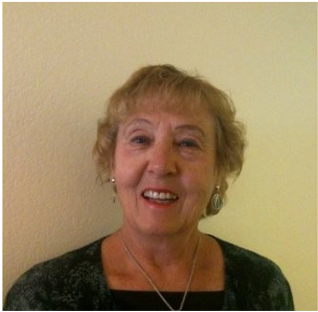
A group of educators from Adams Twelve Five Star School District, a suburban school district outside of Denver, Colorado, believed one answer to this challenge was to strengthen the teaching of science. They were joined by faculty from the University of Northern Colorado, headed by Carol Fortino and Helen Gerretson, who together sought to develop a way to support students in expanding their knowledge of science, and at the same time improve and extend their skills in literacy and mathematics. The meeting led to a two-year project, “Using Literacy Integration for Communicating Scientifically (ULINCS)”, that included 30 elementary teachers from grades three through six in ten schools, five university faculty members, and five district teacher leaders.
The project had two important dimensions: 1) professional development in science, literacy, and mathematics, and 2) the synthesizing of content standards for curriculum integration. The results of the ULINCS project demonstrated that:
Sustained Professional Development in science, math, and language arts lead to a community of ULINCS teachers who were able to. . . Synthesize standards and objectives which led to increased achievement of elementary students in literacy, science, and math, as documented by district and state test data.
The First Link: Professional Development
The university and the school district held a summer institute that focused on science content, literacy, and math strategies, along with companion software. For the ULINCS project, literacy was defined as those skills that relate to reading, writing, speaking, listening, and viewing.
The project provided scaffolding for teachers to cultivate new learning through tasks that allowed them to discover solutions as well as build their abilities to communicate with colleagues and encourage personal reflection on professional growth so that they might better serve as mentors and models to other educators. Instead of feeling isolated, teachers who volunteered for the ULINCS program became members of a larger sustained community of educators.
The Strategies
One of the most telling improvements made by the ULINCS teachers was their ability to acknowledge and change their approach by choosing and synchronizing strategies to enhance curriculum integration. Many of the effective and innovative strategies were adapted from A Handbook of Content Literacy Strategies by Stephens and Brown (2000). A description of some of the strategies follows, with the suggested group format and literacy processes at the end.
Mysterious Possibilities
Mysterious Possibilities involved the teacher displaying a scientific photograph, object, or picture (with or without explanation). After studying the object, the students tried to solve the mystery by brainstorming or predicting possible connections to a specific topic. The teacher then had the class discuss the list of ideas that became a bridge to the new lesson (whole-class speaking, listening, and viewing).
Question of the Day
Question of the Day involved an open-ended question which the teacher (or student) wrote on the board to stimulate thinking and activate prior knowledge. One example was, “How are reading and space travel alike?” The students then discussed their answers orally, wrote in their learning logs, or drew pictures. This was followed by a sharing of answers and discussion (whole-class or small- group speaking, listening, viewing, writing, or visual representation).
Cubing
Cubing (Cowen and Cowen, 1980) encouraged students to construct meaning about a topic from six different perspectives. Each side of the cube required the students to use the following divergent thinking processes:
- Description (What is it like?)
- Comparison (What is it similar to or different from?)
- Association (What does it make you think of?)
- Analysis (How is it made or what is it composed of?)
- Application (What can you do with it? How is it used?)
- Argumentation (Take a stand, arguing for or against it.)
After the teacher modeled cubing with the class, the students selected a topic for writing and spent three to five minutes answering each question on the cube (whole-class or small group listening, writing).
The teachers used these and other cross-disciplinary strategies to engage the students and integrate the curriculum. The use of these new and different strategies was a highlight of the project, although one teacher felt that if a different name was given to a strategy (which can happen with teachers from different content areas) this might confuse the students. She reported, “Some students might be irreparably damaged if next year’s teacher call strategy “x” strategy “y.” However, she countered that the point of teaching a strategy is to help students make meaning saying, “The strategy is a tool; not the point of learning.”
Another teacher wrote in her reflective journal, “A strategist is a problem-solver who has some systematic way of going about things. . . the strategy is an artificial scaffold to help access material that would otherwise be inaccessible.”
The ULINCS integrated science and literacy approach was based on the belief that adults, as well as youngsters, need a purpose to read, to write, to speak, to listen, to view, and to apply mathematics. The strategic teaching of the inquiry-based Full Option Science System (FOSS) science units helped build common experiences upon which to apply literacy skills.
The Second Link: Synthesizing Standards
One innovation of this project was to demonstrate how discrete content standards for science, literacy, and mathematics could be combined into a synthesized standard that would serve as the basis for curricular units integrating literacy and math within the context of elementary school science. When teachers looked at the standards, even within one discipline, let alone across disciplines, they recognized that they could not teach them all as separate units. Then they began to see that there were common concepts within the standards and that there were similarities in the objectives and goals across the standards. The challenge was to produce a different type of integrated unit. This required the teachers to switch to a new conceptual basis and begin a unit, not with a topic, but with specific content standards, and by ending with a synthesis of these standards.
To help bridge this gap, the teachers were given explanations and written examples of synthesizing content standards. Some found these relatively easy to write, while others were bogged down in the wording, thinking it was dense and ponderous, even when the wording was taken directly from the Standards (NCTM, 1989; NCR,1995). By the following summer, teachers were ready to present synthesized standards for their integrated units, to share student work samples, and to discuss their professional development reflections.
A sample comparison of objectives between language arts and science standards revealed similarities in the learning processes described for both content areas. It was determined that the Literacy objectives (in this case, reading objectives) could serve as a tool to access the more specific learnings within the science objectives, which is more content laden.
Table 11.1 – A Comparison of Literacy and Science Standards/Objectives
The proceeding table compares two literacy objectives with two science objectives with their corresponding standards.
| Literacy Standard: Reads to Understand a Variety of Materials | Science Standard: Conducts Investigation |
| Objective 1
Understands a variety of narrative and expository texts at literal, interpretive, and critical levels. |
Objective 1
Reads information to plan and conduct scientific investigations that include asking questions. |
| Objective 2
Increase vocabulary. |
Objective 2
Explain and observe the change in a system using words, diagrams, and graphs. |
The following is a narrative example of how teachers chose to write a synthesis of these two standards for their integrated unit activity. Concepts from mathematical standards are also embedded in the description.
Synthesized Standard for “Were You Aware” Activity
- Students predict and make a graph using the percentages of the types of water found on earth.
- Students read a science story to confirm and adjust their predictions. For this, they set a purpose for reading, then read for understanding.
- Using their new learning, students re-evaluate and adjust the graph.
- Students share their learning and knowledge by writing sentences about the interpretation of the graph, using vocabulary that is mathematically and scientifically accurate.
In comparing the two ways to write standards, one can see that synthesis requires the capacity to incorporate content from literacy, math, and science. The process goes beyond curriculum integration and requires a higher level of conceptualization by the teacher to maximize student learning. The key is that teachers must think about instruction as a unified process.
While planning and writing their integrated science units, the ULINCS teachers volunteered comments from their reflective journals. The following comments illustrate how the teachers and students benefited from content integration as an aide to communicating ideas.
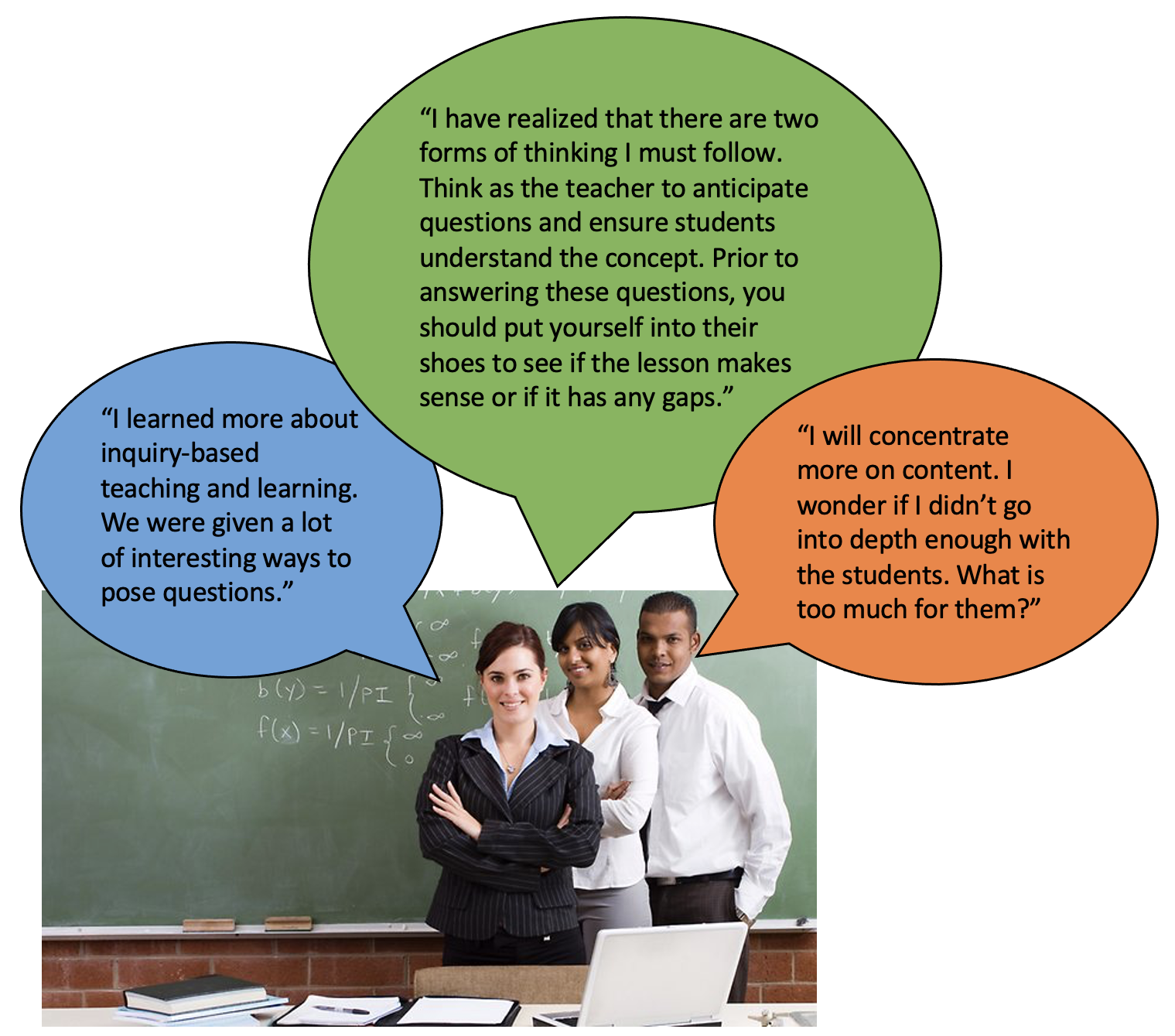
The process of synthesizing standards and objectives was revolutionary because, without it, the planning for teaching and learning events typically fell back into the traditional format of separate subject areas. The positive effect of the synthesized standards was that science could be effectively taught using literacy and math and that students benefit greatly from this new way of thinking.
Student Achievement
A second-strata goal of the ULINCS project was to significantly improve student achievement in the areas of science, literacy, and mathematics as measured by standards-based assessments. The ULINCS teachers represented ten different elementary schools, but results were reported for only seven of the schools since three of the schools had only one teacher at a single grade level. Of the seven ULINCS schools with teacher teams, one was a Title I school with a low socio-economic scale index, and three of the schools had significant numbers of at-risk students, as well as English Language Learners (ELL). All ULINCS teachers gave the Northwest Evaluation Association (NWEA) Science Concepts and Processes Level Tests for both Fall 2000 and Spring 2001. All teacher participants who had complete data for Fall 2000 and Spring 2001 NWEA Level Tests had their data reported in the results. Only the data from the ULINCS teacher participants’ classes were reported for science since their non-ULINCS colleagues were not required to administer the NWEA Science Level Tests.
Results from the Colorado State Assessment Program for Reading and Math represented all the students at grade levels three thru six in each of the ULINCS schools; this included both ULINCS and non-ULINCS teachers at that grade level. Additionally, only grade levels with two or more ULINCS teachers were reported. Since all schools were required by the state or the district to report scores in reading and mathematics, the results were accessible for this study. The test results in mathematics and reading for the academic year represented the percentage of students who were designated proficient or advanced on both the CSAP Reading and Mathematics Assessments for their specific school and grade level. Science, which at the time was not assessed at the elementary level by the CSAP, was assessed by the NWEA Levels Test.
As a result of the ULINCs project, the District Grade Level Achievement tests showed improvement in mathematics, reading, and science. Colorado Student Assessment Program scores were raised in mathematics and reading; science was not tested at this time until grade eight. Six schools showed increased achievement in reading.
Final Thoughts on the ULINCS Study
The findings of the ULINCS demonstrated that elementary teachers and students could derive great benefits from including science in the curriculum when literacy and mathematics standards were synthesized within the planning process and then used as tools to access and express this content knowledge. The ULINCS project began because teachers and university faculty members were concerned about the decreased time devoted to science and the increased time spent on test preparation. This study demonstrates that staff development and the synthesis of standards, coupled with a rich curriculum, can provide a tremendous avenue for advancing student learning.. These are crucial points to be shared with teachers, administrators, parents, and legislators who believe that teaching literacy and mathematics alone will increase student achievement. As the study demonstrated, the opposite is true.
This study demonstrates that staff development and the synthesis of standards, coupled with a rich curriculum can provide a tremendous avenue for advancing student learning.
The authors suggested that more research is needed to continue to understand how content standards in other disciplines may be integrated and synthesized when teachers plan for learning experiences that are meaningful and doable within a challenging academic schedule. When students are motivated to learn about themselves and their world, literacy and mathematics become the natural tools to help them unlock and expand this knowledge.
The ULINCS study is important because it demonstrates the value of curriculum integration and collaboration with teachers and university instructors to show that increased learning as evidenced by increased state assessment scores.
At the classroom level, curriculum integration can be successfully done by teachers who collaborate in the planning process.
For more on ULINCS, access Using Literacy Integration to Communicate Scientifically.
The following article and video demonstrate this collaboration at different levels and with different content areas.
- Collaboration in the Middle Teachers in Interdisciplinary Planning
- Arts Integration: Deepening Understanding of Core Content
ILA 11.0
Choose a content area that is content-centered such as social studies or science that you may want to integrate with a subject area that has process standards similar to the following example. Summarize your integration in the ILA Responses Group in Hypothesis.
Example
Using the following 2020 Colorado State Academic Standards for 8th-grade social studies; reading, writing, and communicating; and math algebra functions, the Can You Solve Abraham Lincoln’s Math Homework?, the excerpt from Henry Ketcham’s The Life of Abraham Lincoln as a secondary source, and the Exercise book fragment: manuscript as a primary source, students could be posed with the task of answering the question, “Was Abraham Lincoln a good problem solver?” Their first task would be to analyze different primary and secondary sources involving key decisions made throughout his life including Ketchum’s book and the manuscript to come up with an answer. They could later be shown the video to validate their conclusion.
Eighth Grade Social Studies Standard
Investigate and evaluate primary and secondary sources about United States history from the American Revolution through Reconstruction to formulate and defend a point of view with textual evidence.
Eighth Grade Reading, Writing, and Communicating
Pose important questions; identity, locate, and evaluate sources; extract and synthesize relevant information, and communicate findings appropriately.
Eighth Grade Math Algebra and Functions
Expressions & Equations: Understand the connections between proportional relationships, lines, and linear equations.
Insight 11.0
Curriculum integration is strengthened by a team of teachers from different disciplines who bring different curriculum viewpoints and strategies to the teaching and learning process which can lead to increased test scores and motivation for both teachers and students.
Summary
Curriculum integration is a relatively new concept in modern education, but a broader view of history reveals that it existed as far back as ancient Greece. The integration of curriculum has many positive aspects as evidenced in the ULINCS study, but without expertise on the part of teachers and support by administrators, the curriculum may be weakened. Many examples of successful curriculum integration and collaboration are available in articles, research, and videos that are readily available to teachers and others interested in this design model.
